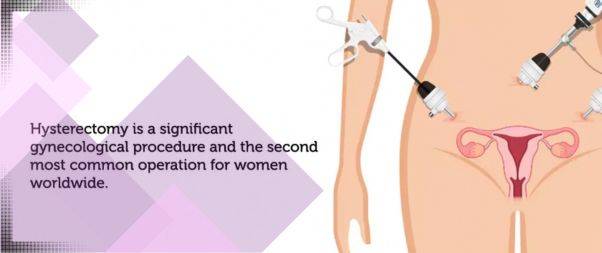Hysterectomy is a common surgical procedure that involves the removal of a woman’s uterus.
It is estimated that about one-third of women in the United States will have a hysterectomy by age 60.
However, this is a significant surgery and understanding its details, risks, and recovery aspects is crucial for women considering this operation.
What is Hysterectomy?

Hysterectomy refers to a surgical procedure that eliminates the uterus, and typically, the cervix.
Depending on the medical necessity driving the operation, it could extend to excision of adjacent organs and tissues, including the fallopian tubes and ovaries.
The uterus is the site of fetal development during pregnancy and its lining is shed as menstrual blood during each menstrual cycle.
Post-hysterectomy, the possibilities of becoming pregnant cease and menstrual periods are permanently discontinued.
Indications for Hysterectomy
A hysterectomy is typically performed to treat health problems that affect the uterus.
These may include
- uterine fibroids (noncancerous growths in the uterus)
- endometriosis (where the tissue that normally lines the uterus grows outside it)
- pelvic support problems (like uterine prolapse)
- abnormal uterine bleeding
- chronic pelvic pain
- gynecologic cancer
It is essential to note that hysterectomy is often considered only when other less invasive treatments have failed or are not an option.
Why is a Hysterectomy Performed?

Hysterectomies are undertaken by medical professionals for several reasons, including:
- Persistent vaginal bleeding that is abnormal or heavy and remains uncontrolled by other treatments.
- Intense menstrual pain that other treatment methods fail to alleviate.
- The presence of leiomyomas, or uterine fibroids, which are benign tumors in the uterus.
- Chronic pelvic pain linked to the uterus and not relieved by other interventions.
- A condition called uterine prolapse, where the uterus ‘drops’ into the vaginal canal due to weakened supporting muscles, potentially leading to difficulty with bowel movements or urinary incontinence.
- Instances of cervical or uterine cancer, or precancerous abnormalities, with the surgery serving as a preventive measure.
- Issues related to the lining of the uterus, such as hyperplasia, recurrent uterine polyps, or adenomyosis.
Types of Hysterectomy
The type of hysterectomy necessary for your situation will be determined by your healthcare provider, taking into account your specific health condition.
This decision will influence whether your fallopian tubes and/or ovaries need to be excised.
- Total Hysterectomy: This involves the removal of both your uterus and cervix, while your ovaries are left intact.
- Supracervical Hysterectomy: This procedure involves excising only the upper section of your uterus, with your cervix remaining in place.
- Total Hysterectomy with Bilateral Salpingo-Oophorectomy: In this procedure, your uterus, cervix, fallopian tubes (in a process known as salpingectomy), and ovaries (oophorectomy) are all removed. For pre-menopausal women, the removal of your ovaries will precipitate the onset of menopausal symptoms.
- Radical Hysterectomy with Bilateral Salpingo-Oophorectomy: This comprehensive procedure includes the removal of your uterus, cervix, fallopian tubes, ovaries, the upper part of your vagina, some surrounding tissue, and lymph nodes. This type of hysterectomy is typically implemented when cancer is present.
Hysterectomy Procedure

Your doctor will decide what kind of hysterectomy you need and the best way to do it.
You’ll put on a hospital gown and be connected to machines that check your heart rate.
A tube called an IV will be put in your arm to give you medicines and fluids.
A doctor called an anesthesiologist will either:
- Give you general anesthesia, which means you’ll be asleep during the surgery, or
- Give you regional anesthesia (also called epidural or spinal anesthesia), which means you’ll be awake but won’t feel any pain.
There are a few different ways your doctor might do a hysterectomy:
Vaginal hysterectomy: Your uterus is taken out through a cut at the top of your vagina. There’s no cut on the outside. Stitches that dissolve on their own are put inside your vagina. This method is usually used for problems like a dropped uterus and other conditions that aren’t cancer. It has the fewest problems and quickest recovery (up to four weeks), and is often the first choice. Most people go home the same day as the surgery.
Laparoscopic hysterectomy: A thin tube with a camera on the end, called a laparoscope, is put into your lower belly through a small cut near your belly button. Surgical tools are put in through a few other small cuts. Your uterus can be taken out in small pieces through the cuts in your belly or through your vagina. Some people go home the same day or after staying one night in the hospital. Recovery is usually quicker and less painful than an abdominal hysterectomy.
Robotic-assisted laparoscopic hysterectomy: Your surgeon does the surgery with the help of a robot. A laparoscope is put into your belly so your doctor can see your pelvic area. Small, thin surgical tools are put in through three to five cuts around your belly button. The robot arms and tools are controlled by the surgeon. Recovery is similar to a laparoscopic hysterectomy.
Abdominal hysterectomy: Your uterus is taken out through a 6- to 8-inch-long cut in your belly. The cut is made either from your belly button to your pubic bone or across the top of your public hairline. The surgeon will use stitches or staples to close the cut. This method is usually used when there’s cancer, when the uterus is big, or when disease has spread to other parts of the pelvis. It usually requires a longer hospital stay (two or three days) and a longer recovery time.
Duration and Recovery Period
The duration of a hysterectomy procedure typically ranges from 1 to 3 hours.
Recovery time after a hysterectomy depends on the type of surgery. For abdominal hysterectomies, hospital stays can last from 2-3 days with a recovery period of 6-8 weeks.
Vaginal, laparoscopic, or robotic hysterectomies often involve a shorter hospital stay and a recovery time of 2-4 weeks.
Patients are given specific instructions about diet, wound care, activities, and follow-up care.
However, this can differ based on factors such as the size of your uterus, the presence of scarring from past surgeries, and whether other tissues (like endometrial tissue) or organs (like your fallopian tubes or ovaries) are being removed alongside your uterus.
Side Effects
Some usual side effects after a hysterectomy include discharge from the vagina (which might last up to six weeks after the surgery) and soreness where the cuts were made.
If your ovaries were also taken out during your hysterectomy, you might start having signs of menopause, such as:
- Feeling very warm suddenly.
- Dryness in the vagina.
- Losing interest in sex.
- Having trouble sleeping.
Your doctor will talk with you about ways to help with these menopause symptoms.
Risk and Complications

Like all surgical procedures, hysterectomies come with a small risk of complications, such as:
- Formation of blood clots.
- Serious infections.
- Bleeding.
- Obstruction in the bowel.
- Internal stitches coming undone.
- Damage to the urinary tract.
- Problems caused by anesthesia.
How much does Hysterectomy Cost?
In India, the typical cost of a hysterectomy surgery usually falls between Rs. 55,000 and 75,000. That said, the costs can vary depending on the city and the hospital.
The price for a laparoscopic hysterectomy in India usually ranges between INR 55,000 and INR 75,000. But, like all surgeries, the exact price can change a bit.
Things like the kind of hysterectomy you get, what parts are removed, which gynecologist you choose, their level of experience, the location of the hospital, and other medical and non-medical costs can all affect the price.
Below is a quick overview of the average costs for laparoscopic uterus removal in a few big cities in India:
Lots of things can change the cost of the surgery.
- The city where you get the surgery
- The reputation of the hospital or clinic
- The fees of the doctor doing the surgery
- The admission fee
- The kind of surgery you get
- Any complications after the surgery
- The type of room you choose for your stay
can all change how much you have to pay.
The total price of the surgery can also be affected by the number of tests you need before the surgery.
The overall price of the surgery can be less if you have an insurance plan that covers some of the costs.
Post-Hysterectomy Care Instructions
Follow the guidance given by your healthcare professional.
- Keeping the surgical cut clean and dry once you’re home is vital. Your doctor will provide detailed instructions about bathing, often recommending to avoid taking baths for at least a month. However, doctors’ advice on bathing may vary based on the specifics of your operation.
- Showering is usually permitted immediately, but ensure the water flows over the incision and doesn’t directly hit it. You can carefully clean any dry tissue near the wound. Instead of rubbing, remember to gently pat the area dry. It’s likely you’ll be sent home with either staples or steri-strips (thin, white bandages) to aid in the healing of your wound. Staples are metal clips used along with stitches to help close the wound.
- A bit of redness around the stitches or staples is normal. The staples are typically removed 10–14 days after the surgery. Steri-strips might be used after the staples are taken out. You can shower with the staples or steri-strips still on, and if the steri-strips start to curl, you can gently remove them. Over time, likely between six and twelve months, the color of your incision will fade and eventually disappear.
- Inspect your incision daily for any signs of inflammation, swelling, discharge, or opening of the wound.
- If you have any surgical drains, you can bathe using a sponge or shower, just ensure to dry the area around the drain and incision properly.
- Wear clothes that are comfortable and loose to avoid any irritation or rubbing against the incision area. You can also cover the incision with a clean piece of gauze to prevent discomfort from your clothes.
- Try to go for a short walk each day as it encourages healthy blood flow and decreases the risk of complications like blood clots in your legs (deep vein thrombosis).
- Try to avoid standing for long periods. As your recovery progresses, you can gradually increase the time you spend standing. Refrain from heavy lifting and stretching.
- Eat a diet rich in fruits and vegetables, and drink plenty of water to avoid constipation.
- If antibiotics have been prescribed to you, be sure to complete the entire course, even if you’re feeling better.
- Avoid inserting anything into your vagina, including tampons, douching, and engaging in sexual activity. Your doctor will inform you when your wound has healed enough to allow these activities, usually after eight weeks.
- Avoid exposing the incision to direct sunlight and refrain from applying any creams or lotions directly on the incision unless directed otherwise.
- If vaginal dryness is a problem, you might find it helpful to use a lubricant or natural oils like sweet almond or olive oil.






